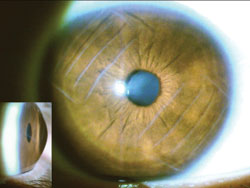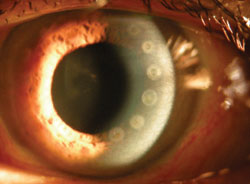Irregular astigmatism should be addressed in cataract surgical plan
Incorporating corneal astigmatism analysis into cataract evaluation helps the surgeon formulate a plan that addresses both conditions.
 Uday Devgan |
With cataract surgery and refractive surgery merging into one specialty, it has become clear that we should aim to address astigmatism at the same time as the phacoemulsification procedure. For regular and symmetric astigmatism, this is typically accomplished with a toric lens implant, corneal relaxing incisions or even by utilizing the effect of the cataract incision. But what do we do in situations in which the corneal astigmatism is irregular or asymmetric?
Before cataract surgery
We can address treatable causes of irregular astigmatism such as pterygium, epithelial basement membrane dystrophy and dry eye syndrome before cataract surgery. These types of lesions that affect the cornea will limit the postoperative refractive benefit of cataract surgery, so every effort to fully treat them should be made. Corneal topography is useful to determine the effect that each of these conditions has on the astigmatism, as well as to determine stability over time.
With pterygia, the elastoic degeneration can affect the conjunctiva as well as the cornea and can induce large degrees of irregular astigmatism (Figure 1). While it may be tempting to perform the pterygium removal at the same time as the cataract surgery, this often results in an unpredictable postoperative refraction. The pterygium makes it difficult, if not impossible, to get accurate keratometry measurements for use in the lens calculations. The best course of action for refractive accuracy is to first remove the pterygium and smooth the cornea, allowing weeks to months for healing and stability. Once the corneal topography is shown to be stable over the serial clinical examinations, accurate keratometry and lens calculations can be done and cataract surgery can be performed.
 Figure 1. This patient has a dense brunescent cataract and a large pterygium that is inducing a large degree of irregular astigmatism as shown on topography (inset). Removing the pterygium first can resolve the astigmatic changes and allow a better refractive benefit from the cataract surgery. Images: Devgan U |
Epithelial basement membrane dystrophy is a relatively common cause of irregular, asymmetric and unstable corneal astigmatism. In mild cases, it may minimally change the corneal topography and keratometric values, while in other cases it can induce a large degree of corneal irregularity, thereby confounding the refractive accuracy and predictability of cataract surgery. In the latter case, the corneal epithelium can be scraped manually or with an excimer laser and then allowed to heal before cataract surgery is scheduled.
Dry eye syndrome can cause corneal irregularity and can often produce white spots or dropout on corneal topography testing. Treatment of dry eye syndrome as well as other ocular surface diseases should be accomplished well in advance of cataract surgery. Once tear film stability and corneal topography consistency have been achieved, it is reasonable to proceed with cataract surgery. These patients should be watched closely in the postoperative period because an exacerbation of the dry eye syndrome and ocular surface instability can resurface.
After cataract surgery
When advanced cataractous changes are present in an eye with a large degree of corneal irregularity, it may be advantageous to simply perform the cataract surgery and address the astigmatism afterwards. Patients with significant central corneal scars, keratoconus, corneal ectasia or other large corneal irregularities may need specialized corneal procedures such as transplants, cross-linking or specialty rigid contact lenses to optimize their vision after cataract surgery. While some surgeons choose to perform a concurrent corneal surgery such as a transplant at the same time as cataract surgery, it is reasonable to perform just the phaco surgery initially, especially in cases of dense cataracts.
In these cases with highly irregular corneas, it is advisable to avoid making incisions into the cornea during the phacoemulsification procedure. A scleral tunnel incision would be a safer choice than a clear corneal incision because it would be less likely to induce further weakness into an already abnormal cornea. It is also important to avoid using a toric IOL in cases in which the patient expects to wear a rigid contact lens after cataract surgery. This is because the rigid contact will effectively unmask the power of the toric IOL (Figure 2).
 Figure 2. This patient has a severe posterior subcapsular cataract along with a severely ectatic cornea from unusual incision refractive surgery performed years prior. The inset shows the profile of this irregular cornea, which requires a rigid contact lens to improve its shape. |
Concurrent with cataract surgery
If the irregular corneal topographic changes are limited to the periphery with a relatively symmetric and stable central cornea, a toric IOL can often be used during cataract surgery. Conditions such as peripheral corneal scars, prior RK and mild forme fruste keratoconus can induce astigmatism that is symmetric in the pupillary zone but irregular and asymmetric in the periphery. The key in these cases is to evaluate the central topography and to ensure stability over time. Toric IOLs work best in cases in which the corneal astigmatism is regular, symmetric and stable (Figure 3).
 Figure 3. This patient has multiple peripheral corneal scars from prior conductive keratoplasty but a clear central cornea that has a regular and symmetric pattern of astigmatism on topography. A toric IOL was implanted with success at the time of cataract surgery. |
Think of cataract surgery as more than just a way to restore clear media to the eye; cataract surgery is our most powerful and frequently used refractive surgical procedure. By incorporating an analysis of the corneal astigmatism at the time of the cataract evaluation, we can formulate a surgical plan to address both conditions and give our patients the best vision possible.

- Uday Devgan, MD, FACS, is in private practice at Devgan Eye Surgery in Los Angeles and Beverly Hills. He can be reached at 11600 Wilshire Blvd., Suite 200, Los Angeles, CA 90025; 800-337-1969; email: devgan@gmail.com; website: www.DevganEye.com.
- Disclosure: No products or companies are mentioned that would require financial disclosure.
